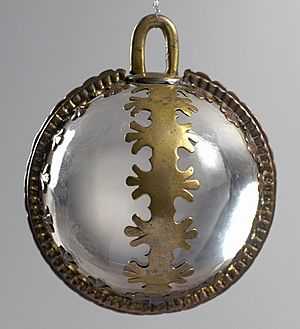Charmstone facts for kids

A charmstone is a special stone or mineral that people from different cultures believed had magical or healing powers. These stones were often shaped by hand, sometimes long or round, and might have holes or grooves. People thought they could bring good luck, protect against harm, or even cure illnesses. They were like ancient good luck charms or amulets!
Contents
Ancient Stones with Special Powers
Charmstones are found in many places around the world, like Scotland and among Native American groups in California and the American Southwest. While people in America usually call them "charmstones," in Scotland, you might hear them called "charm-stones" or "charm stones."
Charmstones in Scotland
In Scotland, charm-stones were often large, smooth pieces of clear rock crystal or other types of quartz. People believed these stones had amazing healing or magical abilities. Often, they would dip the charmstone into water. This "magic water" was then used to help sick people or farm animals get better.
One famous example is the Brooch of Lorn. This is a beautiful, fancy brooch from the late 1500s that has a charmstone set right into it. Important clan leaders would wear it.
Cold-Stones and Ancient Beliefs
Even older stones, called Scottish painted pebbles, might have been used as charm-stones too. These pebbles date back to a time called the Pictish period, from about 200 AD to 800 AD. People used these "cold-stones" to cure sickness in animals and humans even as recently as the 1970s!
There's a story about Robert Burns's friend, Highland Mary, who was very sick in 1786. Some people believed her illness was caused by an "evil eye" (a curse). They told her father to find seven smooth stones where two streams met, boil them in milk, and use that mixture to treat her.
Saint Columba's Healing Stone
The Life of St. Columba, an old book, tells a story about him visiting King Bridei in Pictland around 565 AD. Saint Columba took a white pebble from the River Ness. He blessed it, and it was said that any water it touched could cure sick people. The story says the stone even floated in water and helped cure the king of a serious illness! This stone became a valuable treasure for the king and helped many others.
Belief in charm-stones was also common in medieval Iceland. Today, you can see examples of these stones at the National Museum of Rural Life in Scotland. Another example, set in the Lochbuy or Lochbuie Brooch, is kept at the British Museum.
Native American Charmstones
Unlike Zuni fetishes, which are often carved into animal shapes, Native American charmstones usually don't look like figures. For a long time, experts wondered what these stones were used for. Some thought they might have been weights for fishing nets or had other everyday uses.
However, studies of Native American traditions suggest that charmstones were mostly used in spiritual ceremonies or other important rituals. They were believed to have special powers for healing, protection, or connecting with the spirit world. Researchers have even tried to sort charmstones into different types based on their shape to learn more about when and where they were used.
See also
- Bezoar
- Madstone
- Toadstone
- Tongue stone

